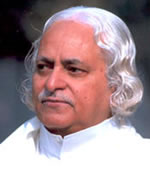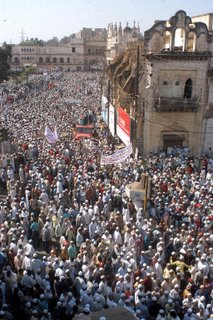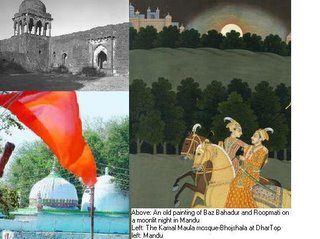1. Kasturi Bai, 58, an old Hindu woman, has not applied oil to her hair for the last several days. She will not during the entire period of ten days.
Amongst those designing the
Tazia is a government employee who is on leave these days to oversee the preparations here. A youth is busy in woodwork while an elderly man sits silently, nearby. Children come and sit with respect.
2. A Muslim police officer, who considers
tazia and '
maatam' as absolutely
un-Islamic and is dead against them, stops a '
sawaari'.
[The
sawaari is a term used for a 'youths', who gets 'possessed' during
Muharram, may reply to questions and is heavily garlanded in the procession.]
The policeman scolds him. "
Don't you have an iota of shame, doing such bid'at despite being a Muslim'. The '
sawari' [youth] sheepishly says...'
Sahab, main Hindu
hoon' [
Sir, I am a Hindu] leaving the cop astonished.
3. Throughout India, eunuchs [the
hijdas] take out the most opulent
tazias.
4.
Amaria Bai, a Hindu, came 150 km from her native village to the state capital to her son just to watch
Muharram. As a child she would come with her father to take part in the procession and now as a grandmother too, she arrives annually.
Soon after partition when Delhi was witnessing a
shaam-e-ghariban as
lakhs of Muslims had left for Pakistan that the Government decided to take out the
sarkaari tazias in keeping with the tradition. The aim was also to show that Muslims still stayed and survived here.
Similar
sarkari tazias that were taken out by former Hindu states like
Holkar,
Scindia in Central Indian region, continue to this day. At several places district collectors or other government officials are guardians of the
tazias.
For several years these
tazias were taken out as hardly a few thousands of Muslims were left in Delhi.
Muharram regained its fervour in Delhi by eighties. From
Muharram in Delhi and Lucknow, where for 17 years ban remained on processions, to the
tribal belt of Bastar and in the South,
Muharram bears the shades of local culture.
I never saw
savaris in UP. So are the '
sher', children painted as tigers wander on the streets in Eastern Maharashtra and
Chhattisgarh during the entire ten days. This makes
Muharram procession or Yaum-e-
Ashura, an all encompassing tradition.
Many friends do not like these practices. But since my childhood I have been fascinated with the way
Moharram brings people together. I never feel that I have any right to make any such pronouncements or judgments.
Artisans across all fields were in form or the other associated with
tazia-making. I remember the carpenter who left all work to return to his hometown to make
tazia in the
mohalla, though he was otherwise a staunch Hindu.
The blacksmith makes knives and arms for the '
akhada'. Similarly the intricate handwork on the
tazias required artisans from all classes and linked them economically to the Muslims. Lately we heard that old tradition of
Muharram was dying in India.
I have also seen conflicts within families where a brother insisted on keeping tradition while the other under influence of other sect or jamaat
trying to stop the practice. [The photo is of
Moharram procession in
Sangli, a district in Maharashtra that has a large tribal populace.]
Read a post on this blog about a Hindu family taking out
tazia for 130 years in Central India
See photos of the unique
Muharram processions in India that show tigers and other interesting facets. See posts
here and
here.
[Harmony exists all around us but is often ignored. Instead, stories of hate, discord and communalism get spread easily.
There are a million examples in our daily lives across India but they don't get promoted, hence, news of hate and discord gets heard more. Let's change it, now. This is a small attempt to change it through Communal Harmony Project]
For reading similar reports on this blog, Click the link
HERE and also find out more about
Communal Harmony Project
#communalharmony #communalharmonyproject #india







































